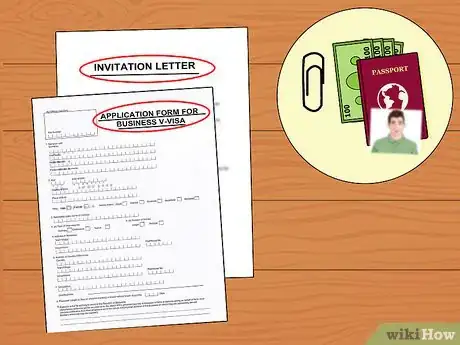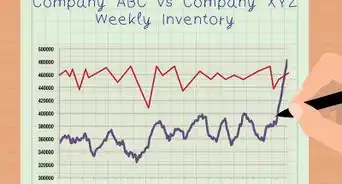This article was co-authored by wikiHow Staff. Our trained team of editors and researchers validate articles for accuracy and comprehensiveness. wikiHow's Content Management Team carefully monitors the work from our editorial staff to ensure that each article is backed by trusted research and meets our high quality standards.
There are 9 references cited in this article, which can be found at the bottom of the page.
wikiHow marks an article as reader-approved once it receives enough positive feedback. This article received 14 testimonials and 93% of readers who voted found it helpful, earning it our reader-approved status.
This article has been viewed 942,651 times.
Learn more...
Importing items from China can be an affordable way to acquire materials for use in manufacturing or products for sale. However, importing items on your own requires establishing relationships, setting up shipping, and navigating the regulatory channels of US Customs. Get started on your way to importing from China by taking steps to set up your import process and planning ahead.
Steps
Finding a Supplier
-
1Make sure you can legally import your chosen item. Most items will be allowed, but there are certain guidelines that must be followed for some types of items. The United States imposes stricter guidelines on agricultural products, for example. Additionally, Chinese laws may prohibit the export of certain items, like animal by-products or fake designer clothes and accessories. Check with the laws and regulations of both countries before making an order.
-
2Make a list of Chinese exporters, or suppliers, who can provide you with your product. Fortunately, Chinese exporters actively seek out import partners in the US through online forums and trade websites.[1] You can find suppliers using online outsourcing directories or professional sourcing companies. Some good places to start include Alibaba.com, China.cn, and Analema International.
- Export agents in China are very commonly hired by Chinese exporters. Some of these export agents are also 3rd-party suppliers, while others just provide export services.
- You can also visit trade fairs (two trades shows in China are worth mentioning, Canton Fair and East China Fair), search suppliers on Google Map, check customs data, go to local wholesale market, filter sellers on retail sites and use many other ways to find potential suppliers.
- If you don't have much experience dealing directly with suppliers in China, another option is to seek the help of a commission-based China sourcing agent or sourcing service provider. However, the fee can range from 3 to 15% of the purchase price. Be aware that there might also be hidden commissions between sourcing agents and Chinese manufacturers. The biggest benefit of working with a good agent is its network and relationship with the qualified and trustworthy manufacturers, whom you might find hard to access on your own. If you decide to go this route, after working with sourcing agents a few times and familiarizing yourself with the process, you can eventually manage your own deals without their help.
Advertisement -
3Contact each supplier on your list. Once you have a list of exporters, you can begin asking questions in order to narrow it down to the supplier who is right for you. Some things you will want to ask each exporter to provide you with include:
- Client references. A reputable supplier should be able to provide you with client testimonials and references. Once they do, be sure to check them.
- Business licensing information. You want to be sure that any company you do business with is properly licensed and in compliance with all applicable trade laws in order to avoid future legal problems which may affect your business.
- Manufacturing and staffing information. Be sure you understand the exporter’s relationship to the manufacturer. Do they manufacture the product themselves? If not, do they get paid by the manufacturer as well?
- The name and location of the factory producing the product. If an exporter refuses to provide you with the name and address of the factory where the product is manufactured, they may not be a reputable supplier.
-
4Investigate the product. Request information regarding the experience of each factory in producing your particular product. You should also ask for samples of the product. Unless you will be manufacturing your own new product, the supplier should be able to provide you with samples of the product so that you can get a better idea of the quality and know ahead of time exactly what you are paying for.
- Cost is not the only the consideration when choosing a supplier; quality may be just as important, and the manufacturer’s experience can be a good indication of the quality of work.
Making an Order
-
1Make a trip to meet with your supplier. If at all possible, it's best to schedule a visit to your supplier in China. This will help you establish a relationship with the supplier and get a sense of how well their business is operated. This provides a better opportunity for negotiation than working on a deal over the phone.
- The website should offer the supplier's physical addresses and contact details. If this information is absent, ask for their contact details and if they don’t mind you coming in and checking on their offices. This shouldn’t be a problem at all if they are not hiding something from you.
- Visiting trade shows is a great way to see suppliers face-to-face without traveling to China.
-
2Obtain a business visa. In order to enter China, you will need to apply for and receive a Chinese M visa, which is the visa specific to business activities. You can apply for this visa at the nearest Chinese consulate. In order to get the visa, you will have to submit the required documentation and items, which includes:
- A valid passport from your current country of residence.
- A black and white photocopy of the picture page of your passport.
- Black and white photocopies of previous Chinese visas you have obtained (if any).
- A recent, passport-style photo of yourself.
- A completed visa application form (available at the Chinese Embassy's website).
- An invitation letter from the supplier you are meeting.
- A fee of approximately $140, plus any additional service or administrative fees.[2]
- It may take three weeks for your visa to be processed and shipped once you have applied for it. However, you may be able to pay for expedited service. Ask the consulate for details.[3]
-
3Negotiate a deal with the supplier. Remember that business interactions with Chinese exporters are governed by Chinese culture and customs, and different negotiation skills and tactics may be required. Some things to keep in mind when negotiating with Chinese suppliers include:
- The focus is on relationships. Chinese do not do business with companies, they do business with people, and each business deal creates a new relationship with the other party. Chinese exporters are therefore not likely to jump into a deal until they have had the opportunity to get to know you a little.
- Reliance is on moral influence, not legal practice. Chinese executives tend to rely more on a party’s moral obligation, rather than its legal one. This does not mean you should ignore the wise business practice of having a signed contract, but you should let your desire to get a signature on a contract take a back seat to building a trusting relationship where each party will feel morally obligated to perform, even if they did not have a signed contract.
- Hierarchy is important. Shaking the hand of a low ranking executive first or calling a high-ranking executive by his first name can jeopardize interpersonal relationships and affect a Chinese executive’s willingness to negotiate. Pay close attention to how executives address each other and follow their lead.[4]
-
4Begin placing your orders. Each company will have a minimum order amount and a basic shipping agreement. Most exporters expect orders of at least 10,000 units, depending on the item in question. The most common types of shipping arrangement for Chinese exports to the U.S. include:
- Carrier air mail. This service is best for samples and smaller orders, but can be costly. Check with companies like DHL International, UPS, and EMS to set up an import shipping account.[5]
- Sea freight. For larger orders and bulky items, or to save money, you can use sea freight to import your items. This type of order is shipped as either a full container load (FCL), which is a full shipping container for your items, or a less than container load (LCL), which allows your shipment to share space in the same container with other shipments. FCL shipments are cheaper per cubic meter but require a large order to make the cost worth it.
-
5Pay for your products. To place your order, you will have to pay a deposit on the value of your order. Usually an initial deposit of between 30-50% will be requested by a Chinese manufacturer to get your product/order into production. The remainder is paid upon delivery of the goods. Never pay the entire amount of the purchase price upfront. If there is a problem with the order, you may not be able to get your money back.
- Remember that the wholesale cost of your product is not simply the recorded cost of the item on the order, but the total cost of having it shipped to you, including taxes, tariffs, shipping, and insurance fees.[6]
- A letter of credit is commonly used in trade with China. Go to your bank to get detail formality and cost.
- Payment for Chinese exports is most often made by credit card, but many Chinese suppliers also accept other forms of payment, such as cash, check, or even PayPal.
- You need to have a good estimate of the landing cost before you make your order. Landing cost = cost of the goods + transport costs by forwarder + import duties (if any) + local transport costs + cost of service providers (inspections, agents, etc.).
- There may be many hidden costs and you can consult an import management company, but the best way to avoid bad surprises is by making a first order of a small quantity, and collect all costs and fine tune your landing cost estimate.
- Use escrow services for payment whenever possible. Escrow companies allow a buyer to deposit funds with an independent third party, to be delivered to the seller once he or she has fulfilled his or her end of the supply and shipping agreement.
-
6Avoid payment fraud. Some importers may experience this type of fraud when placing their orders. It typically involves their payment for orders being sent to the wrong bank account, which can leave both the supplier and the importer out of a large amount of money. Reduce your risk of this type of fraud by following two simple steps:
- Don't send your payment to a bank account that isn't registered under the name of the company you are ordering from.
- Don't send your payment to a bank account registered in a different city from your supplier, even if the name on the account is similar.
- Otherwise, you will simply lose your money and have virtually no legal recourse to get it back.
Getting Your Items Through Customs
-
1Hire a customs broker. Locating and hiring a licensed customs broker can make your importation process much easier. This professional facilitates communication between you and the government, fills out and files necessary paperwork, and can help you navigate import regulations. They can also help estimate import costs and how long the import process will take. Just make sure that you can cover their fee with the sale of your imported products.
- Neglecting compliance can be very costly. This may force you to pay expensive and unexpected customs duties, such as the anti-dumping duty, as well as risk delaying your customs clearance. This will cost you expensive storage fees at a railway station or container yard. Avoid these expenses by hiring a qualified customs broker.
- Find a certified broker by searching on the website for the National Customs Brokers and Forwarders Association of America.[7]
-
2Acquire necessary permits and licenses. Work with your customs broker to identify which licenses and permits you will need, if any. Apply for them through the appropriate US government channels and wait for your application to be accepted before placing an import order.
- You will need a specialized license to import items that fall under certain categories, such as food products, plants, animal products, prescription medication, trademarked items (brand name or designer goods), and copyrighted items (CDs, DVDs, etc.).
- The specific licenses needed for each good may come from different government agencies. You can find which licenses you need by visiting the US Customs and Border Patrol's website and searching for "licenses and permits."
-
3File the Import Security filing (ISF). The ISF is a document specific to items shipped by sea freight that provides advance shipment information to US Customs. This document should be filed 24 hours before shipment sets sail. If this is not done by either you or your broker, you may have to pay a $5,000 fine. The data points required on the ISF are:
- Identities of the buyer and seller.
- Importer of Record number.
- Consignee numbers.
- Country of Origin.
- Ship to party.
- Harmonized Tariff Schedule of the United States number (if your Chinese supplier has some export experience, he should have the harmonized schedule code, or HS code, for your product).
- Manufacturer or supplier information.
- Container stuffing location.
- Consolidator.[8]
-
4Get your product through US Customs and Border Protection (“CBP”). For help with this, contact a service port of entry near you. Ask to speak with a CBP import specialist assigned to the product you are importing. Import specialists can provide you with product specific requirements, advisory duty rates, answer your questions about filing an entry, and can assist you with preparing and filing the required paperwork. You can locate a port of entry and its contact information by visiting the CBP’s website.
- You should be aware of any entry requirements specific to the particular product you are importing, including those of federal agencies besides CBP.
- For more information about getting your product through U.S. Customs, read Basic Importing and Exporting at CBP's website: http://www.cbp.gov/trade/basic-import-export.
-
5Submit initial import documents. Once the goods are received by the port of entry, you (or your customs broker) have five days to submit the first round of required import documents. These must be accepted by customs before further documentation can be filed. Required documents include:
- Bill of lading.
- Packing lists.
- Commercial invoice.
- Certificate of origin.
- Customs bond.
- Inward cargo manifest or immediate delivery form.
-
6File additional documents. After the first documents are accepted by the port of entry, you or your broker now have ten days to file two additional required documents. These are the entry summary (US Customs Form 7501) and any relevant invoices that can be used to value the shipment.
Taking Possession of Your Items
-
1Pay your import duties. Your import duties will be calculated using the value of your shipment as estimated by customs officers and the shipment's grouping on the harmonized tariff schedule. The value of the shipments includes the price paid, commissions incurred from the purchase, royalty fees, license fees, packing costs, and the value of assists (specialized machinery or molds used in the manufacturing process). Your duties are then determined by using the tax rate specific to items of your shipment type on the US Government's Harmonized Tariff Schedule.
- Tariffs may vary by origin as well. For example, liquor (alcoholic beverages containing over 20 percent but no more than 50 alcohol by volume) is taxed at a standard rate of 8.4 cents per kilogram and an additional 1.9% of total value. However, this fee is waived when the items are coming from certain locations (including Canada and Singapore).[9]
- If any of your filed documents are inaccurate, you will need to file corrected documents before you can pay your duties.
- Your duties are due within ten days of the receipt of your initial import documents.
- Your customs broker should be able to help you estimate the cost of your duties before you import the goods.
-
2Arrange for pick-up and transport. Contact a commercial cargo company to arrange to have your shipment picked up at the port of entry and shipped to your warehouse or local resellers. Cargo companies can be located by consulting your local yellow pages or favorite online phone book.
-
3Check your shipment for accuracy and damage. Once the items have made it to you, look at the packaging and items themselves for any damage sustained over the course of the trip. If there is significant damage, you may want to rethink your choice of shipping method or urge your supplier to better prepare your items for shipment.
Community Q&A
-
QuestionSince China has multiple vendors, who would manage the container loading?
 Community AnswerHire a responsible freight forwarder with an office or agent in China. They will coordinate your orders from multiple vendors and consolidate them into one shipment.
Community AnswerHire a responsible freight forwarder with an office or agent in China. They will coordinate your orders from multiple vendors and consolidate them into one shipment. -
QuestionWhat are the payment conditions?
 Community AnswerGenerally, they outline the terms of transfer of ownership and when payment is expected to be rendered.
Community AnswerGenerally, they outline the terms of transfer of ownership and when payment is expected to be rendered. -
QuestionMust you have a corporation if you want to import goods from China?
 李腾Community AnswerYou can find an agent or importer to help with the goods. If you only buy a small quantity of products, you do not need a corporation.
李腾Community AnswerYou can find an agent or importer to help with the goods. If you only buy a small quantity of products, you do not need a corporation.
Warnings
- Search online for the name of any supplier you are considering. Watch for results from websites that track scam suppliers and disregard the supplier if others have had bad experienced with them.⧼thumbs_response⧽
- During the initial contacts, wholesalers should request to see a business license or sales tax ID. These are required by legitimate wholesalers. Deceitful or fraudulent wholesalers, however, may not ask for this documentation.⧼thumbs_response⧽
References
- ↑ http://www.itintl.com/how-to-import-from-china.html
- ↑ http://www.saporedicina.com/english/chinese-visa-application/#chinese-visa-5b
- ↑ http://www.visarite.com/china_business_visa.htm
- ↑ http://www.hbs.edu/faculty/Publication%20Files/09-076.pdf
- ↑ http://mywifequitherjob.com/importing-wholesale-products-from-china/
- ↑ http://www.practicalecommerce.com/articles/430-The-Basics-of-Importing-Products-From-Overseas
- ↑ National Customs Brokers and Forwarders Association of America
- ↑ http://www.cbp.gov/sites/default/files/documents/import_sf_carry_3.pdf
- ↑ https://hts.usitc.gov/
About This Article
To import from China into the USA, find exporters or suppliers in China using online outsourcing directories such as Alibaba.com. Pick a supplier based on such things as client references and business licensing information. Before placing your order, verify that you can legally acquire your chosen items. Also make sure you can pay the deposit, which is typically 30-50% of the total order price. Finally, look into hiring a customs broker to make the importation process easier. To learn how to calculate import duties, keep reading!



















































































